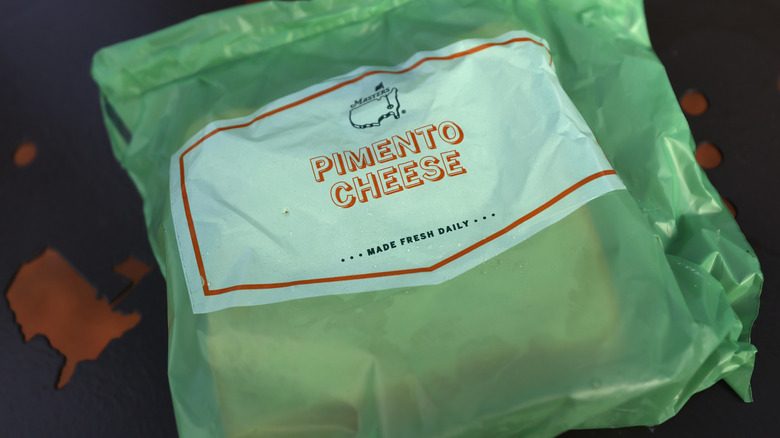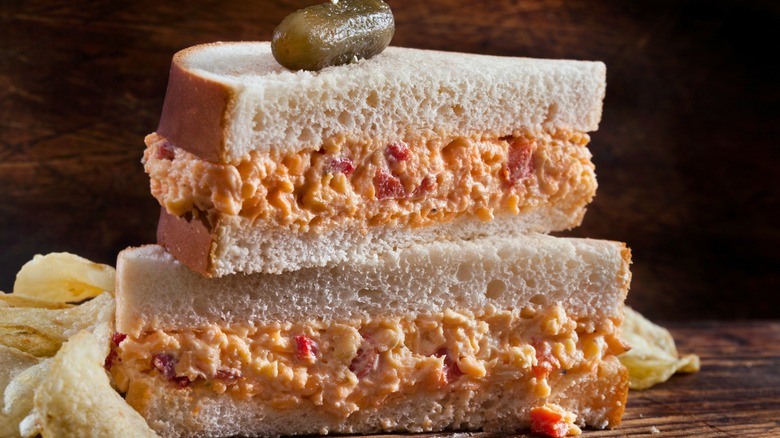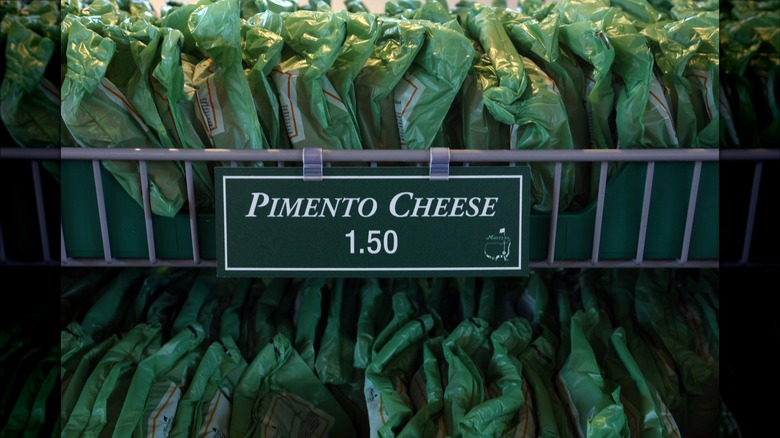How Pimento Cheese Sandwiches Became A Key Part Of The Masters
Golf fans nationwide are gearing up for the upcoming 2024 Masters Tournament at Augusta National Golf Club, where they will get a chance to watch the pros compete in the first of four major golf tournaments of the year. Attendees will get to see the iconic green jackets worn by previous tournament winners, and they'll get a taste of the tournament's culinary claim to fame: the Masters' pimento cheese sandwich. Pimento cheese is a beloved Southern staple made with simple ingredients, but patrons of the Masters will have their hearts set on tasting a bit of history as they unfold the green plastic wrapping around the famed $1.50 sandwich.
In the 1940s, not long after the Masters began, a married couple named Hodges and Ola Herndon brought pimento sandwiches they had made to the tournament and sold them to attendees for just a quarter. They continued the tradition until the 1950s when caterer Nick Rangos took over food production at the Masters and created his own version of the Masters' pimento cheese sandwich. His recipe was a masterpiece that became a beloved staple of the annual tournament for over forty years. However, in 1998, the Augusta National Golf Club switched things up again and brought in local restaurant chain Wife Saver to meet their food service needs. Rangos, not happy about Augusta's decision to replace him, refused to give up the recipe for his pimento cheese, which started a string of occurrences that would eventually lead to controversy.
PimentoGate
When Wife Saver took over food production at Augusta National, attendees of the annual Masters tournament already had a taste for their beloved "Carolina Caviar" and were not enthusiastic about the recipe change. Franchise owner Ted Godfrey was determined to figure out how to replicate Rangos' recipe but had little initial success. Godfrey once lamented about his struggle in an interview with ESPN, "The cheese was a distinct cheese. It was more orange than most cheeses. I knew I didn't have the right cheese. We had cheeses and cheeses and cheeses. I can't tell you how many 35-dollar cases of cheese we'd been through."
As luck would have it, Godfrey discovered a frozen batch of the original pimento that clued him into the correct cheese for the recipe. However, after a few attempts to replicate it, the recipe still wasn't right. In a moment of ingenuity, Godfrey figured out he could call the distributor that had previously supplied Rangos his ingredients. Soon, he had discovered the secret ingredient, and the Masters' pimento cheese sandwich once again became a course staple for hungry tournamentgoers.
Unfortunately, this didn't earn Godfrey enough favor with the golf club to keep him employed. In 2013, Augusta National switched things up again and started catering in-house, which left him no place there. In response, Godfrey took a page out of his predecessor's book and refused to give Augusta National the recipe for his Masters' pimento cheese sandwich, which created the controversy known today as PimentoGate.
What is the secret ingredient?
The mystery ingredient used to make these iconic sandwiches is still obscured in secrecy. Those listed on the back of the wrapper at the Masters include extra sharp cheddar, Monterey Jack, mayo, cream cheese, pimentos, onions, salt, black pepper, garlic powder, cayenne pepper, and added preservatives. Folks who have regularly attended the Masters have said this recipe is a drastic improvement from what Augusta sold when Godfrey exited, but it's still not quite the same.
As for the undisclosed ingredient, Godfrey isn't talking, and Rangos took the secret to his grave. The cream cheese in the current recipe could be part of the solution, though other recipes have sparked attention calling for ingredients like bleu cheese and Dijon mustard. Whatever its makeup, patrons of the Masters Tournament continue to enjoy this classic sandwich in droves.
The memorable taste people experience could have to do with several non-culinary factors. Enjoying it next to blooming azaleas and immaculately maintained greens accompanied by the smell of fresh pine. The $1.50 price tag couldn't hurt either. The tradition of opening the green plastic wrapping in an awe-inspiring environment might have just as much to do with experiencing a blissful moment when biting into the sandwich as it does with the secret ingredient. The Masters' pimento cheese sandwich will remain as much a staple of the tournament as the coveted green jackets, and if you ask most patrons about the taste, they will tell you it's a hole-in-one.


